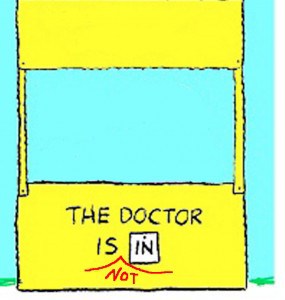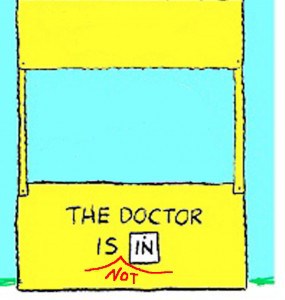“The doctor of the future will give no medicine but will interest his patients in the care of the human frame, in diet and in the cause and prevention of disease.”
– Thomas Edison
 We are at a crucial juncture in history, with technology and tools developing so rapidly in the medical field that healthcare as we perceive it will be radically different 10 years from now. There are clear signs that the healthcare industry is now undergoing massive transformation and the change is driven not by the medical community but by entrepreneurs and technologists everywhere. Technology and innovation are moving at such a rapid pace that it will fundamentally shift the power of healthcare from the hands of the doctor to the individual. We can, in the near future, see the doctor when the doctor is not in.
We are at a crucial juncture in history, with technology and tools developing so rapidly in the medical field that healthcare as we perceive it will be radically different 10 years from now. There are clear signs that the healthcare industry is now undergoing massive transformation and the change is driven not by the medical community but by entrepreneurs and technologists everywhere. Technology and innovation are moving at such a rapid pace that it will fundamentally shift the power of healthcare from the hands of the doctor to the individual. We can, in the near future, see the doctor when the doctor is not in.
The coming decade will be transformational, both for doctors in the way they practice and for us as consumers and how we manage our own health. Here are 10 trends which are already re-defining how the healthcare sector will look like in the future, along with links to organisations which are leading the way.
1. Unbundling of hardware and software – Most medical technology, whether in the intensive care unit or your hand held blood sugar monitor was developed as hardware. Most of these will be unbundled, with the software and analytics on the cloud and the hardware focusing on sensing and detection. This drastically reduces costs and allows for remote diagnosis and remote servicing of equipment.
Stasis Labs – www.stasislabs.com
2. Emerging networks of patients and caregivers – A fundamental shift in power from doctors/hospitals to individuals will lead to the building of networks around health conditions and even risk to particular health conditions. The knowledge base built by individuals and their care givers contributing granular data could help in uncovering new patterns and possible cures.
Patients like Me – www.patientslikeme.com
3. Miniaturization of Diagnostics: Thirty years ago a test for diabetes had to be done in a laboratory where you would go in the morning having fasted, wait for your blood or urine to be taken, and then tested using a bunch of chemicals. Now this can be done at home at any time using a hand held device. This will become the norm for any test we go to the laboratory for today. Miniaturisation is the rule rather than the exception. Most medical tests will be done at home and data plugged to the cloud for analysis or reporting.
Theranos – www.theranos.com
4. Remote care: With shrinking diagnostics and cloud analytics, remote diagnosis will be easier. Video-based consultation for most non-emergency conditions is becoming commonplace. Imagine virtual consultation and remote diagnosis with miniaturisation, coupled with robotic surgery. The location of the expert doctors becomes irrelevant.
Doctor On Demand – www.doctorondemand.com
5. Data analytics to drive decisions: Medical diagnosis till now has relied on physician knowledge and analysis along with diagnostics data. This is now being fundamentally redesigned using massive computing systems like IBM Watson Health, which has the entire medical encyclopedia on its engine and can provide answers on demand, in seconds. The unreliability of an individual’s analysis or a limited number of people will be replaced by data analytics to drive diagnosis and treatment decisions. This is critical in specialties like oncology where the right pattern identified can lead to far better outcomes.
Flatiron Health – www.flatiron.com
6. Algorithms replacing doctors: Can medical knowledge be codified and algorithms built to enable better diagnosis and care? Turns out we can. With increasing knowledge being assembled in the cloud, and diagnostics equipment now fuelling this database along with more refined treatment protocols, we are more likely to see most routine cases diagnosed without getting a doctor involved.
MoodGym – https://moodgym.anu.edu.au/
7. Virtual reality and holograms: In those rare instances where you really need to see a specialist with specific skills or knowledge and experience, virtual reality and holograms will enable a seamless and rich interaction. Virtual reality could also be a great treatment modality for behavioural issues like various phobias, e.g fear of flying.
Psious – www.psious.com
8. 3D printing and technology: With the costs of printers and printing dropping rapidly, 3D technologies will revolutionise the fields of dental care, orthopaedics and neurosurgery technologies. This enables better precision and informed decisions tailored to individuals before and after surgery.
Osteo3D – www.osteo3d.com
9. Genomics and Proteomics: Thelast decade has seen tremendous progress in the field of genomics since the human genome was decoded in 2001. Today we have the ability to sequence genomes much faster, at a fraction of the cost. Most importantly, technology to edit and recreate genomic information is now becoming possible, truly providing us the tools to manage our own risks.
Editas Medicine – http://editasmedicine.com/
10. Coach led, physician supported: The role of the physician will be radically different in the future, with more clients interfacing with health coaches. They have access to knowledge, algorithms and data at their fingertips and can coordinate with physicians if required. This new generation of health coaches will be our front line and first point of contact, leading to better outcomes and individualised care.
Vida Health – www.vida.com


Ashwin Naik (@ashwinnaik)
The Doctor Is NOT In, the Doctor Will See You Now http://t.co/AsMIZpwHYe
@sajid_v
RT @ashwinnaik: The Doctor Is NOT In, the Doctor Will See You Now http://t.co/AsMIZpwHYe
@HCITExpert
The Doctor Is NOT In, the Doctor Will See You Now https://t.co/9O7ltTCA7Z via @ashwinnaik blog #HITsmIND
@labsoftnews
RT @HCITExpert: The Doctor Is NOT In, the Doctor Will See You Now https://t.co/9O7ltTCA7Z via @ashwinnaik blog #HITsmIND
Goodbye 2015, Hello 2016 | ashwinnaik.com
[…] – The Doctor is not in, the Doctor will see you now […]